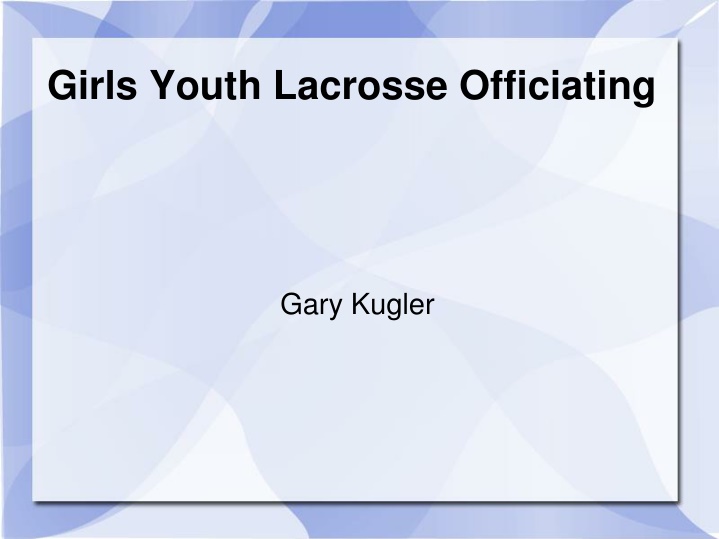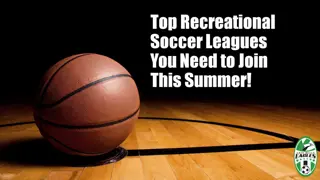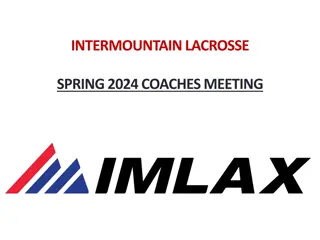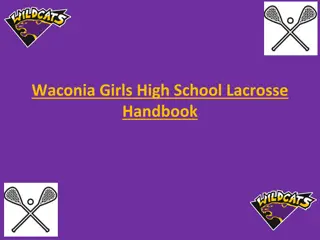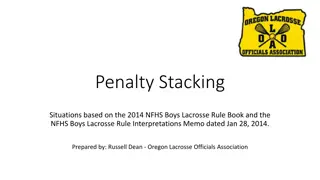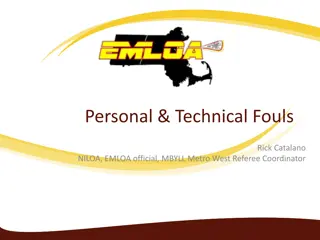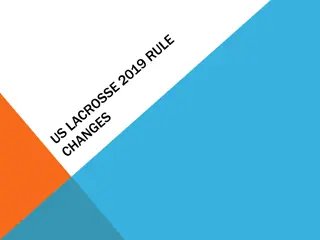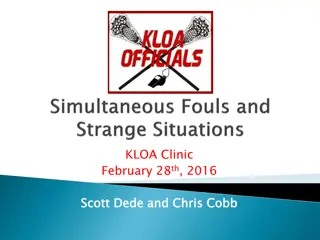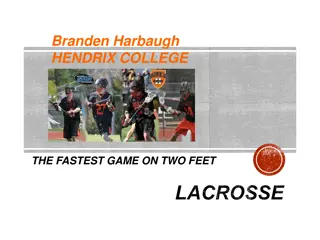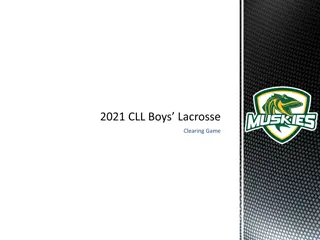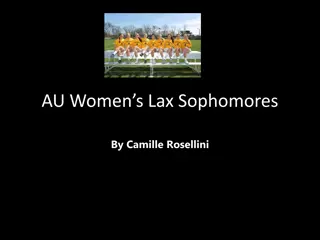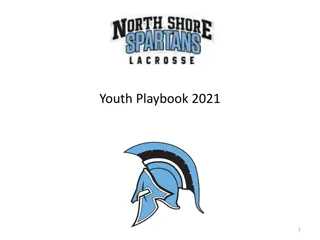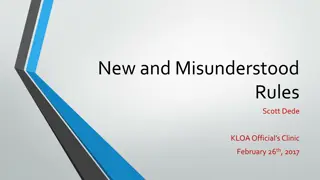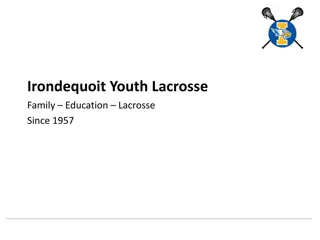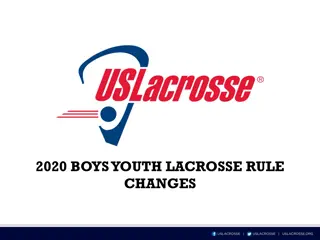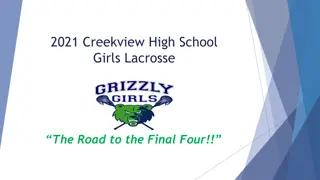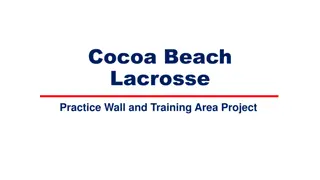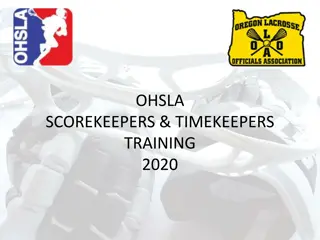Guide to Becoming a Lacrosse Official for Youth and High School Leagues
Explore the process of becoming a junior lacrosse official, from training requirements to on-field experience and testing. Learn about different levels of officiating skills, example test questions, and the importance of officiating in youth sports. Discover how parents and young girls can benefit from participating in lacrosse officiating programs.
Download Presentation

Please find below an Image/Link to download the presentation.
The content on the website is provided AS IS for your information and personal use only. It may not be sold, licensed, or shared on other websites without obtaining consent from the author.If you encounter any issues during the download, it is possible that the publisher has removed the file from their server.
You are allowed to download the files provided on this website for personal or commercial use, subject to the condition that they are used lawfully. All files are the property of their respective owners.
The content on the website is provided AS IS for your information and personal use only. It may not be sold, licensed, or shared on other websites without obtaining consent from the author.
E N D
Presentation Transcript
Girls Youth Lacrosse Officiating Gary Kugler
My Background Youth and HS rated official for two years Coached for Brigade (Girls and Boys) Co-Commissioner of Girls Program for Brigade Daughter spent 6 years in MBYL/Brigade Wife Head Coach for 6 years in MBYL/Brigade Wife is Battlefield HS Coach 4 years, Third as head coach of girls program
How one becomes a Junior Official Junior/Youth officials must take a 6 week class 12+ classroom hours total with head of youth officials in NVYLL HS officials are the same On field training 3-4 partial games pre-season 25 question open book test Must get 20 of 25 correct (80%) HS is 45 of 50 correct (90%) Must be a member of US Lacrosse Typically start younger umpires on K-2 and 3-4 games Great way for young girls to earn money and learn life skills Great way for parents to spend time with their daughters
Example question from youth test In order for a defensive player at the 14U/12U level to be called for 3 seconds in the arc the following needs to happen: a. She is marking an opponent who is directly behind the goal circle b. She is double teaming a non-ball player c. She is marking her opponent within a stick s length d. She is triple teaming the ball carrier within a stick s length
Example question from youth test In 10U lacrosse, a defender may earn the ball by the 3 seconds closely guarded rule if while playing defense she: a. Holds her stick in a checkable position to the ball carrier b. Remains holding her stick in a checkable position for 3 seconds c. Has two hands on her stick for this entire 3 seconds d. All of the above
Example question from HS test After a draw, and before possession is established the ball touches a red player and goes out of bounds between the restraining lines. How will play be restarted? a. A redraw will be taken because no possession was gained. b. The blue center will be given possession at the spot of the center draw. c. The blue player closest to the ball will be awarded the ball 2 meters inside the boundary. d. The blue player closest to the ball will be awarded the ball 4 meters inside the boundary. Note: this is different then a chased and deflected shot
Example question from HS test The White defense has received a yellow card and is playing short a player for 2 minutes; Blue attack is on a scoring play. Trail official discovers the White team has only 3 players behind the restraining line. The trail umpire raises her arm to indicate White defense is offside. Blue shoots and the White goalkeeper saves the shot and now has possession of the ball in the goal circle. What procedures should the officials follow? a. The official will continue to hold her whistle because the defense is not impacting play. b. The official will call the offsides and then Blue attack will be awarded a free position at the center of the 8m arc. Closest defense player will go 4m behind. Defense player closest to the restraining line will move back onside. The arc will be cleared. c. The official will call the offsides and then award an alternate possession to the appropriate team. d. The official will call the offsides and then Blue attack will be awarded a free position at the center of the 12m fan. Closest defense player will go 4m behind. Defense player closest to the restraining line will move back onside. Penalty lane will be cleared.
Overview of Rules 2017 Girls Lacrosse Rule Book is 112 pages long New Separate Youth Rule book as of 2017 that is 86 pages long (companion) 2016 Officials Manual is 216 pages long List of Fouls in 2017 (62 total) 26 Major fouls 17 Minor Field Fouls 9 Goal Circle Fouls 1 Team Foul (Off sides) 9 Misconduct Fouls 5 Major Fouls must be carded Check to the Head Dangerous Contact Dangerous Propelling Dangerous Follow Thru Slash
New Rules for 2017 Stick checks may only be requested during stoppage of the game clock Stick checks may be requested immediately following regulation or overtime Penalty administration for dangerous shot and illegal shot shall be aligned with the ball being given to the closest defender Players must remain below the restraining lines during the draw until the official signals possession by winding their arm Players may use their feet to move the ball to an advantageous position (aka goose the ball) Looking to shoot (NOTE) has been eliminated from the Obstruction of Free Space to Goal criteria will discuss more later
New Restraining line Rule on Draw Notes on the Draw first There must be 12 players on the field before the start of each draw unless a team does not have 12 eligible players in uniform or they are playing with fewer than 12 as a result of a card or cards being given A maximum of 3 player from each team may be between the restraining lines during the draw until the whistle blows, all other players, including each teams dressed goalkeeper, must be below either restraining line On the whistle, all players below the restraining lines may not cross until A player on either team has gained possession of the ball The ball goes out of bounds off of a player The ball crosses the restraining line A whistle stops play for a foul When any of these events occur, the draw is complete Umpire indicates possession/release of draw by raising arm overhead and moved by the side of the body in large clockwise motion On the word ready the players taking the draw must remain motionless except for head movement until the whistle. On the whistle the two opponents must immediately draw their crosses up from the starting position. The flight of the ball must attain a height higher than the heads of the players taking the draw
Some clarifications on Draw Rule from Rules interpretation meeting Possession on Draw Rule: Players may reach over the restraining line to play a ball in the air, this included a bouncing ball, it may be grabbed in the air as long as the stick is not grounded at any time. Any player(s) from below the RL who attempt to play a ball that is between the RL must keep their feet behind the line until possession is gained or the ball crosses wholly over the RL. Can we exchange players on the field before or after the draw and while the ball is between the restraining lines? Yes, however, you cannot exceed 3 players from each team. It's about the numbers.
Some clarifications on Draw Rule from Rules interpretation meeting Kicking the Ball: During a scrum or when the ball is on the ground players may kick it as long as it is not dangerous. Players may kick the ball in any circumstance other than a shooting attempt. They may kick the ball to keep it from going out of bounds, to kick it out of a scrum or to kick it to a teammate. Keep in mind, BODY BALL IS STILL A MINOR FOUL. Players may not allow any part of her body (other than the foot) to deliberately impede, accelerate or change the direction of the ball.
Rules to Note Covering guard a ground ball with her foot or crosse preventing an opponent from playing the ball Simple enough, but it is allowed in a couple of situations Goalkeeper may rake a ball back into the circle provided that no player from the other team is within playing distance and is disadvantaged because the goalkeeper covered the ball This rule does not prohibit a player from stopping a rolling ball by momentarily placing the crosse over the ball, unless this directly prevents an opponent from playing the ball. Nor does it prohibit a player from placing her crosse between an opponent s crosse and the ball to flick/push a ground ball to an open space or to a teammate.
Rules to Note Flick/Push as noted previously players may flick/push the ball to an open space or teammate, however Dangerous Propelling (MANDATORY CARD): propel the ball with her crosse in a dangerous or uncontrolled manner at any time. NOTE: A shot, throw, bat, or flick of the ball without regard to the positioning of a field player is dangerous propelling. Can a player in a scrum really see an open player or space? Is it a great play or Dangerous Propelling? Players may now kick the ball in a non-shooting attempt to move the ball
Rules to Note Mouthguards - All players must properly wear a professionally manufactured intra-oral mouthpiece that fully covers the teeth. The mouthpiece shall be of any readily visible color other than clear or white and must not have graphics of white teeth. It shall include occlusal (protecting and separating the biting surfaces) and labial (protecting the teeth and supporting structures) portions and shall cover the posterior teeth with adequate thickness. There may be no protruding tabs for field players.
Rules to Note Checking the bottom end or handle of the crosse is legal as long as there is no illegal body contact and the check does not cause the crosse or the ball to go into the player s sphere. Not recommended for youth, but also not illegal Cannot use webbing to hook the stick
Different rules between US Lacrosse and NVYLL Number of coaches on sidelines NVYLL = 4 US Lacrosse = 3 Timeouts NVYLL = 2 US Lacrosse = 1 Substantial advantage regular season and playoffs (5 goal differential). Coach may waive NVYLL = Yes US Lacrosse = No One Pass Rule NVYLL = Yes (except Full Check) US Lacrosse = No OT Rules are different Lots of changes in 2017 for youth rules with # of players on field, field size, timing, etc NVYLL is not following the latest guidelines by US Lacrosse for Youth Lacrosse Howard Kartell is overall NVYLL commissioner, was MBYL Commissioner for many years
Common Rule Misunderstandings Picks Shooting Space Chasing of shot: Deflection vs Control Normal Substitutions Time Outs Checking at the youth level Illegal stick to body contact Slow Whistle / Yellow Flag Goalies clearing ball out of goal circle Player Yelling
Picks You must be stationary to set a pick. False This is not basketball Rule: Illegal Pick: Set a moving or stationary pick out of the visual field of an opposing player which does not allow enough time or space to stop or change directions and contact occurs
Shooting Space 2017 Rule - Obstruction of the Free Space to Goal (shooting space): with any part of her body guard the goal outside the goal circle so as to obstruct the free space to goal, between the ball and the goal circle, which denies the attack the opportunity to shoot safely and encourages shooting at a player. The Obstruction of the Free Space to Goal rule is in effect when the ball is within the critical scoring area and above the goal line extended. The critical scoring area is defined as the area from the 12 meter fan to the end line. 1. This positioning applies only if initiated by the defender and not if she is drawn into the free space to goal by an attacking player. 2. This positioning applies to a defender not marking an attack player within a stick s length. Note: Defense players who are double or multiple teaming a player without the ball and are within a sticks length are exempt from the obstruction of free space to goal. They must however continue to abide by the 3-second rule.
Free Space to Goal (Shooting Space) 2016 Rule - Obstruction of the Free Space to Goal (shooting space): with any part of her body guard the goal outside the goal circle so as to obstruct the free space to goal, between the ball and the goal circle, which denies the attack the opportunity to shoot safely and encourages shooting at a player. The Obstruction of the Free Space to Goal rule is in effect when the ball is within the critical scoring area and above the goal line extended. 1. This positioning applies only if initiated by the defender and not if she is drawn into the free space to goal by an attacking player. 2. This positioning applies to a defender not marking an attack player within a stick s length. NOTE: This call should be made only if the player with the ball has the opportunity to and is looking to shoot. Scenario 1: An attack player is being double or triple teamed. She does not have the opportunity to shoot. Obstruction of free space to goal should not be called. If she shoots, strong consideration should be given to calling dangerous propelling. Scenario 2: An attack player has the opportunity to shoot but is looking to pass to a teammate. Obstruction of free space to goal should not be called. 2017 Rule Same as above except the NOTE was dropped, but ..
Free Space to Goal (Shooting Space) Specifically called out in situations and rulings section of 2017 rulebook An attack player is looking to pass to her teammate to her left while between the 12 meter and 8 meter. Ruling: Obstruction of free space to goal should not be called. She has relinquished the opportunity to shoot. So while the specific NOTE was removed, it still seems that the player must be looking to shoot to get the shooting space call!
Chasing shot: Touch vs Control When a shot or deflected shot on goal goes out of bounds, the player who is inbounds and nearest to the ball (stick or body) when it crosses the boundary will place the ball in her crosse and stand 2m inside the boundary line from the spot where the ball went out of bounds. Opponents must give the player with the ball at least 1m of free space. If the goalkeeper while within her goal circle is the nearest to the ball when it crosses the boundary, she will remain in her circle to restart play. If the goalkeeper, while within her goal circle, is the nearest to the ball when it crosses the boundary she is awarded the ball and will remain in her goal circle to restart play. Any players whose momentum has carried them below the goal line extended, after the whistle has sounded, should be instructed to move back above the line prior to restarting play. NOTE: A deflected shot is one that goes directly out of bounds after hitting the goal post or the goalkeeper s crosse or body. A ball that rebounds off the goal post, the goalkeeper, or the goalkeeper s crosse and then off any field player s crosse/body or the official s body and directly out of bounds will be considered a deflected shot on goal. A deflection occurs when any player merely touches the ball with her crosse or body and does not gain any distinct/clear advantage or control the ball.
Normal Substitutions At any time during play through sub area Entering player must wait until exiting player has come off of field After a goal is signaled No need to wait for exiting player At halftime and overtime Not allowed: During timeouts During injuries (except for injured players) After officials hand is in contact with both centers sticks at the draw While switching ends during OT period
Time Outs Two per game, one during entire OT Regular time Time Outs do not carry over to OT May be requested by the head coach or any player on the field After a goal is scored During possession when team is in clear possession of the ball In this case players must leave sticks on field marking where the were before the time out was taken Again, no substitutions during possession time outs
Checking at the youth level No checking at K-2 (U9) and 3-4 (U11) grade level Modified Check at 5-6 (U13) and 7-8 (U15) level The entire stick must be below the shoulder of the ball carrier The check must be in a direction downward and away from the attack player s body Officials should be aware of the attack cradling her stick into the well- placed defender's stick. This is good defense, not a check When the attack is passing or shooting, and contact is made with a defender s stick that is in good defensive position, this is not a stick check. No limits for 7-8 A level Never check: In The Sphere Towards the body
Illegal Stick to Body Contact Rule 10.1.1h Illegal Stick to Body Contact: cross to body, for example; A stick held in a horizontal position that makes contact with an opponent s body. NOTE: Horizontal position is defined as the head of the stick dropping below the 10 o clock or 2 o clock position. Cross-Check: Use the shaft of the crosse to hit, push, or displace an oponent whether or not the stick is horizontal. This includes, but is not limited to, thrusting, jabbing, pushing, or displacing any part of an opponents body
Illegal Stick Contact from 2016 Ref Manual A player must not initiate crosse to body or body to crosse contact. a. Send a strong message that a player s stick must not be coming into contact with another player s body, nor can a player run into an opponent in order to draw this foul call. b. Defenders will not be allowed to stand with their stick against a player s body, lower the head of the crosse into a horizontal position that makes crosse to body contact, reach out with the stick while in motion and hit or hold a player s body, or in any way make stick to body contact. Attack players who initiate contact with a defender s stick in a legal defensive position will be called for a foul. USL Considerations: Horizontal Stick A horizontal stick held by a player who is participating in play is in an illegal stick position. If stick-to- body or body-to-stick contact occurs, a foul will be called on the player who is holding the horizontal stick. A horizontal stick is defined as one that is below 10 o clock or 2 o clock. If an attack player makes contact in a meet and greet context with a defender and moves away, this continues to be a legal move by the attack. If the defense has her stick in a horizontal position, it is a foul on the defense only. If an attack player charges into a defender, this is a foul on the attack. The same criteria used in the past to determine this foul continues to apply charge, barge, shoulder, or back into an opponent or her stick. If the defense has her stick in a legal position, it is a foul on the attack only. If the defense has her stick in an illegal position, both players are committing fouls and this results in a throw. If an attack player is setting a pick on an opponent and is holding her stick in a horizontal position, this is a foul on the attack if contact is made with the stick. A defender may drop her stick into a horizontal position to fill passing lanes, shadow an opponent s stick and occupy more space provided there is no contact.
Slow Whistle / Yellow Flag A slow whistle is a held whistle for a Major Foul by the defense, in the critical scoring area when an attack player is on a scoring play. The official will indicate this slow whistle by raising a yellow flag vertically above her head. A slow whistle is in effect when an attack player in the critical scoring area is on a scoring play and is fouled by a defense player committing a Major Foul but retains possession of the ball or when an attack player in the critical scoring area is on a scoring play and a Major Foul is committed against an attack teammate without the ball. The official immediately blows the whistle when there is an obstruction of the free space to goal. The official may, at any time following the flag, blow the whistle to halt potentially dangerous play. A scoring play is a continuous effort by the attacking team to move the ball toward the goal and to complete a shot on goal. The scoring play is over when: a. a shot is taken. b. the attacking team loses possession of the ball. A bounce pass is not considered loss of possession. c. the attacking team passes or carries the ball behind the level of the goal line and stops the continuous attempt to score. d. the attacking team stops the continuous attempt to score, or the player with the ball is forced by the defense to lose her forward momentum. e. the attacking team fouls.
Slow Whistle / Yellow Flag If the attacking team chooses to shoot the advantage indicated by the flag is complete, the official lowers the flag, and play continues. If the shot on goal is successful, the goal counts. A free position will be awarded to the player fouled or to the attack player nearest the spot of the foul if: a. the attacking team does not shoot and the scoring play ends. b. the shot is affected by the foul so that no advantage is gained. c. a cardable foul is committed by the defense. The offending or nearest defense player is penalized according to Major Foul conditions. The next nearest defense player may move to 4m relative to the player with the ball. All players and their crosses must move out of the penalty lane until play is restarted. The goalkeeper may return to her goal circle if she has moved outside the goal circle during the slow whistle (flag raised) and has not fouled. If during a slow whistle situation, the attack player or one of her teammates commits a foul, it will be treated as an offsetting foul and alternate possession will be awarded at the designated spot nearest to the spot of the foul that caused play to stop. For a major foul by a defense player which occurs outside the 8 meter arc, and the scoring play ends inside the 8 meter arc without an additional foul occurring the free position will be taken on the spot of the foul by the player who was fouled or attack player nearest to the spot of the foul. All players bodies and crosses must be cleared sideways from the penalty lane relative to their position at the time of the whistle.
Goalkeeper clearing ball out of goal circle Rule 7.1.3 - Once a team gains possession of the ball in the goal circle and the ball is cleared, the team must not intentionally return the ball to their goal circle until the ball has been played by another player. Cleared any action taken by a player within the goal circle to pass or carry the ball with her crosse out of the goal circle Played refers to an action whereby the ball leaves the players crosse and is touched by another player, or her crosse is checked crosse to crosse by an opposing player, or play is stopped due to a foul by her opponent. The ball does not have to be successfully dislodged from the crosse. From an umpires perspective We are taught to think cleared and played when the ball leaves the goal circle If the goalie walks the ball out of the circle, and then is pressured heavily by multiple players but not checked , she cannot throw the ball back into the goal circle to get out of the jam Goalie may not carry the ball into the goal circle, they must propel it in and then follow it
Players Yelling 12.1.1 Misconduct: The white attack has an 8m free position. On the whistle, the blue team crashes into thearc and screams at the shooter. RULING: This may be misconduct. While yelling to communicate is acceptable, screaming at a player is not. Warn the defense and card if it continues. (Page 63 2017 rule book)
Youth Umpire Interviews What do coaches do that bothers/interferes with you during the game: Yell out calls before you can even blow the whistle When they challenge calls and then do not respect you when you stand your ground What do coaches do that you like or helps you do your job: Have the girls ready to start immediately Have the field set up correctly When they come back after the game and thank you for umpiring or doing a good job What did you like the best about your playing days in youth league, what would you recommend Keep it fun with games during practice, but still focus on improving Always keep girls updated on rules and teach the latest rules, keep it fun. Remind the players that it is competitive, but they are there to have fun and the coaches should do their best to make it fun.
